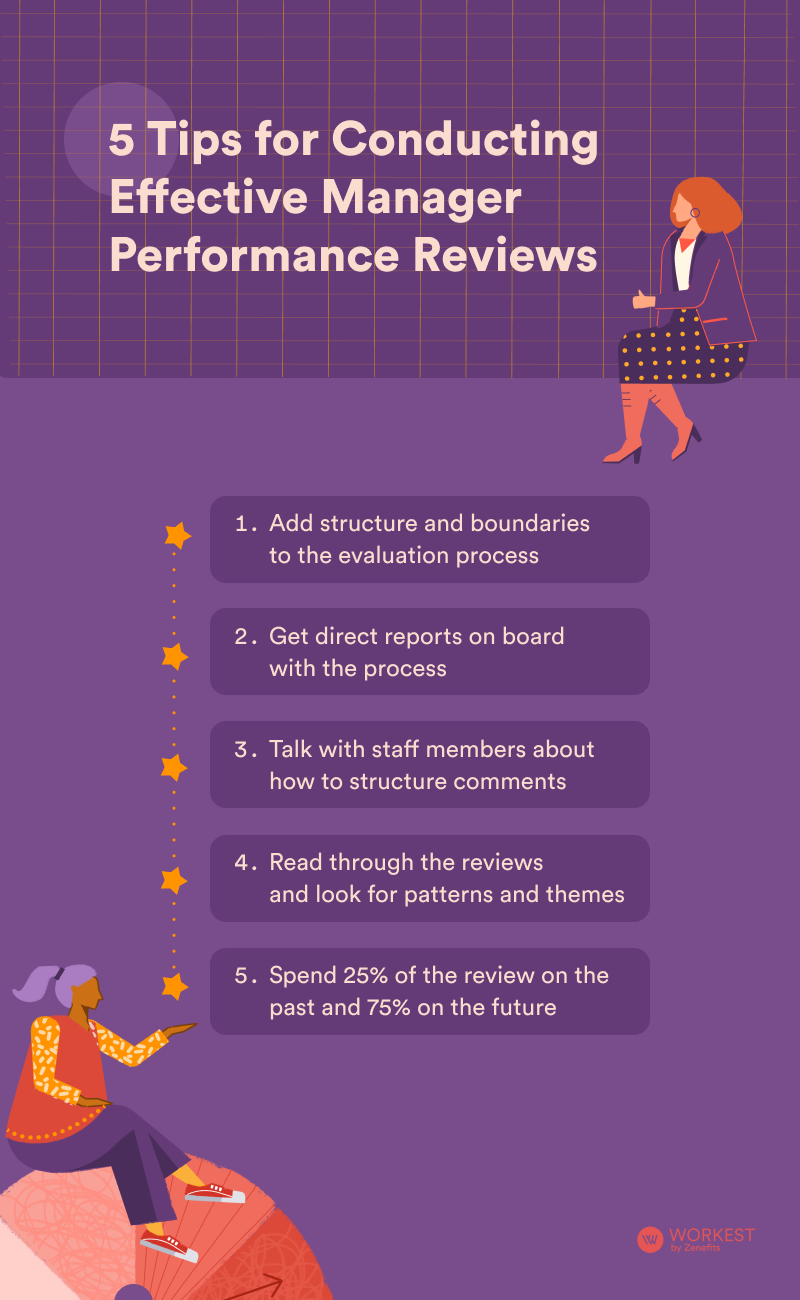Input from employees who work directly under a manager can be insightful and can lead to better team cohesion and productivity.

Here's what you need to know:
-
An emerging trend in performance reviews is to look at the review from a wider perspective — in addition to staff being evaluated by their managers, staff members are now being encouraged to chime in about their managers
-
The value of their input has the potential to improve day-to-day operations as well as future growth for the company and all employees involved
-
To conduct effective manager performance reviews, add structure and boundaries to the evaluation process and get a manager’s direct reports on board
-
Talk with staff members about how to structure comments
-
Read through the reviews and look for patterns and themes
-
Spend 25% of the review on the past and 75% on the future
Performance reviews are an important tool for business and its workers. These annual (or more frequent) meetings discuss issues that have arisen in the past and plan for the future.
At every level, performance reviews inform workers of what’s important to their organization, their manager, and their staff. Employee are better able to deliver on those expectations when they’re clearly outlined and discussed.
An emerging trend in performance reviews is to look at the review from a wider perspective. In addition to supervisory staff being evaluated by their manager, staff members are now being encouraged to chime in.
Input from employees who work directly under a manager can be insightful and can lead to better team cohesion and productivity.
Staff members may not have been asked to evaluate their manager in the past. They may be unprepared or hesitant to do so: but encourage them to participate.
The value of their input, and the information that may be revealed, can be highly relevant. It has the potential to improve day-to-day operations as well as future growth for the company and all employees involved.

Add structure and boundaries to the evaluation process
A recent report in SHRM discussed the 360-degree evaluation process, which includes reviews from direct reports (as well as peers and managers).
One expert advised using the process as a means to develop managers with potential, rather than weed out the bad ones. To get managers on board with the process, communicate clearly with your supervisory and rank-and-file staff that that’s your goal.
The aim isn’t unlimited complaints, but areas where growth is a possibility. Most direct-report evaluations are anonymous, giving employees room to be candid, but there can (and should) be boundaries.
Structure direct-report evaluations tailored to a moving forward approach. Include questions that are targeted toward growth and development.
Ask ‘what can your manager do to better support you?’ or ‘what does your manager do currently that helps you perform?’ Use Zenefits’ performance review generator for sample questions and inspiration or to structure questions that meet your company’s specific needs.
Get direct reports on board with the process
The next step will be getting employees to participate. Some may be concerned their comments will be used against them; others may worry their concerns will not be acted upon. It will be management’s responsibility to allay those and other apprehensions.
The message must be clear to all staff (and managers) that the goal is to grow, not to punish. If employees have a specific concern it should be brought to HR or a team leader immediately, not held onto until performance evaluation time.
When asking staff to review their own manager, ask them to keep progress at the forefront. The better their manager performs, the more they can support and develop their staff. It’s in every employee’s best interest to have the best possible manager. Reviews can pave the way.
Talk with staff members about how to structure comments
Ask staff to include how their manager can improve, and in which areas; and where they’re strong and successful. Even though comments may be anonymous, ask for specifics.
You may use a template or standardized questions baked into the review, but leave room for essay-type comments as well.
Outline that the goal is growth and development, with a ‘help me help you’ mindset.
Talk to staff members about what to include, with suggestions on how to structure comments:
- What does my manager do that supports my day-to-day work?
- What does my manager do that supports my short- and long-term career goals?
- Additionally, what would I like to see more of from my manager?
- What would I like to see less of from my manager?
- Where could my manager benefit from training and development?
- How will that help the manager, team, and company?
Remind staff members that the goal isn’t to castigate their manager, but to set everyone up for future success. You’re looking for feedback that triggers understanding and growth, not complaints that are current or long overdue.
Once you’ve provided tips and set boundaries, it’s time for managers to message staff asking them to participate. Have them request that workers be honest so they can grow as a manager and better help the team.
Outline that the goal is growth and development, with a ‘help me help you’ mindset.
Read through the reviews and look for patterns and themes
As you collect employee comments, look for patterns versus one-offs. There may be a consistent theme that’s positive or negative that requires attention.
Work with the manager to understand the employees’ points of view and direct the discussion to growth and development. There may be some eye-openers for the manager (and you), but don’t turn the session into a ‘woe is me’ meeting.
There may be areas where a manager thinks they’re doing well that are far-removed from what employees really want.
These types of reviews can reveal employee priorities versus their manager’s and how to realign. They may uncover areas that are urgently in need of development, or those where the manager excels and should remain focused.
The goal is to uncover areas for growth as well as areas of competencies. Comments that are not praising are opportunities.
Most managers work hard to support their staff. A clearer understanding of what employees want provides a better chance to do just that.
When managers do better, so does their team. Everyone’s work (and work day) gets easier and more pleasant.
Managerial reviews are as (or more) important as staff reviews
For some companies, managerial reviews are a low priority. If the team is working well, turnover is low, and productivity is high, there’s an ‘if it ain’t broke don’t fix it’ mentality.
While the short-term reward may be continued performance, the long-term cost may be growth. Where can this well-run team go in the future with an even stronger manager? What opportunities are they, their staff, and your business missing out on by maintaining the status quo?
Managers need and want feedback as much as their staff. Managers who are consistent in providing reviews and feedback to their own team may be messaging to you just how valuable they think the process is.
For managers who are less-than-stellar in reviewing their own workers, managerial evaluations can remind them how important these tools are and even provide guidance on how it’s done well.
Spend 25% of the review on the past and 75% on the future
Work with supervisors in a positive way when you review them: encourage them to do the same with their staff.
When the review is a negative experience, it’s easy to understand why everyone wants to avoid it. When it’s forward-thinking, with short- and long-term career planning in mind, it’s welcome and even anticipated.
Performance reviews ideally focus only marginally on the past; and then only when it can inform action for the future. What’s done is done: if you didn’t address it before, is it relevant now? If it is, then deal with it, if not, move on.
A best practice may be to spend 25% of the review on the past and 75% on the future. Reviews may reveal an area that has been problematic: discuss it to understand, but spend the bulk of the time looking for ways to correct and develop for the future
A review is not a substitute for dealing with bad managers
If you have bad managers, and you probably already know who they are, they should be dealt with. Waiting for employees to anonymously complain about an abusive or ineffective manager on an annual basis is too little, too late. Consider how much engagement, productivity, and even staff have been lost during that gap time.
Don’t rely on team members to let you know their leader is not suited for the work. Identify bad managers through pulse surveys and (hopefully infrequent) exit interviews. Then take the initiative to upskill their leadership abilities or move them away from those responsibilities.
Manager performance reviews can be an excellent tool for business if they’re structured correctly and forward-thinking. They present an opportunity for candor and outline avenues to grow and develop. When managers and staff buy into the process, the entire organization benefits.






